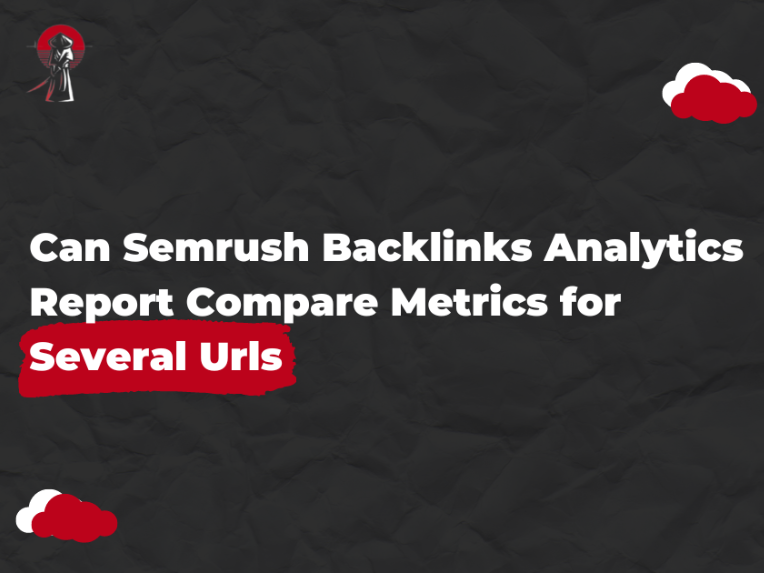In the industries of SEO and digital marketing, comparing the effect of backlinks is important. One powerful tool offered by a well-known SEO tool provider is SEMrush. It is the Backlinks Analytics Report. With this tool, users may explore a website or URL’s backlink profile in great detail, giving them insightful information that helps guide their SEO strategy. Can many URL metrics be compared at once using the SEMrush Backlinks Analytics Report? Now let’s examine this characteristic and see how it might help your SEO strategies.
Introduction
In today’s online world, every company owner wants to increase their website rankings. One of the important methods to gain this is to obtain high-quality backlinks from reliable sources. Semrush Backlinks Analytics Report allows SEO specialists and digital marketers to analyze backlink profiles in-depth. Users can plan to increase the authority and visibility of their website by knowing the linking domains, anchor texts, and authority scores.
Understanding SEMrush Backlinks Analytics Report
Let’s take a look at Semrush Backlinks Analytics Report and its SEO toolbox before we get into its features. SEMrush is famous for its detailed approach to SEO and offers tools for competitor analysis, site audits, and keyword research. The Backlinks Analytics Report, in particular, seeks to provide thorough insights into a website’s backlink profile.
Semrush Backlinks Analytics Report compiles data from numerous web sources and compiles billions of links into its database. SEMrush is able to give users thorough insights into backlink profiles by utilizing this enormous data pool, which helps them comprehend the amount and caliber of links heading to their websites. The tool is made to do more than just perform basic link analysis; it also offers useful indicators that help guide strategic SEO choices.
Capabilities of SEMrush Backlinks Analytics
More than just a basic link analysis is offered by Semrush Backlinks Analytics Report. It provides a wealth of metrics that are necessary to determine the quantity and type of backlinks pointing to a specific URL or domain. Among these metrics are:
- Domain Authority: A metric used by SEMrush to criterion how strong a website’s backlink profile is in comparison to other websites.
- Types of Backlink: SEMrush provides insights into the variety of a website’s link profile by classifying backlinks into follow, nofollow, text, image, redirect, and frame links.
- Referring Domains: Indicates the number of unique domains linking back to the analyzed website, highlighting the breadth of its backlink network.
- Anchor Text Analysis: Identifies the specific text used in clickable links pointing to the website, which influences keyword relevancy and SEO performance.
Comparative Analysis with Several URLs
More than just a basic link analysis is offered by SEMrush’s Backlinks Analytics Report. It provides a wealth of metrics that are necessary to determine the quantity and type of backlinks pointing to a specific URL or domain. These metrics include:
- Benchmark Performance: To determine the strengths and weaknesses of various websites, compare their backlink profiles with one another.
- Identify Competitor Strategies: Examine the sources of your rivals’ backlinks and evaluate how well they are able to draw in relevant backlinks.
Steps to Use SEMrush Backlinks Analytics
Using SEMrush Backlinks Analytics is straightforward:
- Accessing the Tool: Navigate to your SEMrush account’s Backlinks Analytics section after logging in.
- Customers can use the Backlinks Analytics tool with just a few clicks because of SEMrush’s user-friendly user interface. After registering in, users can customize their study by entering the URLs they want to examine and adjusting characteristics like link type and date range.
- Setting Parameters: Enter the URLs you want to examine, then modify the filters according to date ranges and link types.
- Users are guaranteed to receive targeted and pertinent insights on their backlink profiles thanks to the opportunity to define specified parameters. Users can concentrate their analysis on the most relevant data for their SEO strategy by filtering data based on recent links or certain categories of backlinks (e.g., follow or image links).
Interpreting the Metrics
Following research, Semrush Backlinks Analytics Report provides a thorough summary of the backlink profile for every URL. Understanding these signals is significant to developing an effective SEO strategy. For example, a website may get a significant boost in search engine results if it has high-quality backlinks from reliable domains.
Case Studies and Examples
To illustrate the practical applications of Semrush Backlinks Analytics Report, consider the following examples:
- Case Study 1: A startup looks at the backlink profiles of its rivals to find holes in their network and chances to build new linkages. By using SEMrush’s comparative analysis tool, they find that their rivals are more well-known on reputable websites related to their sector.
- Case Study 2: By comparing metrics over time, an e-commerce site uses SEMrush to track the success of its link-building activities. Once they start using targeted link-building tactics, they see a progressive increase in the number of referring domains and domain authority ratings.
Limitations and Considerations
While SEMrush Backlinks Analytics is a powerful tool, it’s essential to consider its limitations:
- Data Accuracy: Backlink data accuracy might be impacted by external factors like website updates or algorithmic modifications. It is advisable for users to update their assessments on a frequent basis to incorporate the latest accessible data.
- Interpretation: For a comprehensive approach, metrics should be understood in combination with other SEO elements (such as content quality and keyword relevancy). If there are a lot of backlinks, but they are not from reliable or relevant sites, then the quantity does not always translate into great SEO.
Advanced Tips for Effective Analysis
For advanced users looking to maximize SEMrush Backlinks Analytics:
- Filters and Sorting: To concentrate on particular kinds of backlinks (like follow vs. nofollow) or domains (like.edu vs…com), use filters. This focused strategy can reveal undiscovered possibilities for obtaining worthwhile backlinks.
- Integration with SEO Strategy: For better outcomes, integrate backlink analytics into more comprehensive SEO efforts. Utilize SEMrush data, for instance, to find influential people or websites in your niche that would be a good fit for partnership.
Future Trends in Backlink Analysis
Semrush Backlinks Analytics Report keeps updating its products to match industry expectations as SEO changes. More advanced metrics and predictive analytics to foresee SEO trends might be incorporated into backlink analysis in the future. Proficient artificial intelligence systems have the ability to examine backlink trends and provide methods for enhancing the relevance and quality of links.
Conclusion
In conclusion, digital marketers looking to improve their SEO efforts will find the SEMrush Backlinks Analytics Report to be a useful resource. Users can obtain practical insights into their own backlink profiles and those of their competitors by concurrently comparing metrics for many URLs. With SEMrush, you can analyze competitors, develop authority, and improve your SEO strategy—all of which are essential for success.
Extended Content
Advanced Tips for Effective Analysis
For digital marketers and SEO professionals, mastering Semrush Backlinks Analytics Report can significantly enhance their ability to optimize websites for search engines. Beyond basic link analysis, SEMrush offers several advanced features and tips for extracting maximum value from backlink data.
Utilizing Filters and Sorting Options
Semrush Backlinks Analytics Report provides robust filtering options within its Backlinks Analytics tool, allowing users to refine their analyses based on specific criteria. Here are some practical ways to use filters effectively:
- Link Type: Filter backlinks by type (e.g., follow, nofollow, text, image) to understand the composition of your backlink profile. This helps in identifying opportunities to diversify link types for a more natural and effective SEO strategy.
- Domain Authority: Sort backlinks by domain authority to prioritize outreach efforts. In terms of SEO benefits, concentrating on high-authority domains can produce more significant outcomes.
- Anchor Text: Make sure the distribution of your anchor text matches your target keywords and SEO objectives by analyzing it. A well-balanced and naturally occurring link profile benefits from a good blend of branded, keyword-rich, and organic anchor texts.
Integrating Findings into SEO Campaigns
The true value of Semrush Backlinks Analytics Report lies in its ability to inform broader SEO strategies. Here’s how you can combine the insights from backlink analysis into your SEO strategy:
- Competitive Analysis: Compare your website backlinks with your competitor’s backlinks using SEMrush. Based on rival strategies, determine openings and gaps and modify your link-building activities accordingly.
- Content Strategy: Use backlink data to find naturally occurring backlink-attracting content. It analyzes the content types like blog posts, infographics, case studies, etc. They are most likely to get quality backlinks and focus on creating it more.
- Link Building: Create a detailed strategy for gaining backlinks by using the insights obtained from SEMrush. To increase success rates, focus on domains that are probably to offer worthwhile backlinks and customize outreach tactics.
Future Trends in Backlink Analysis
Search engines are always evolving, and this is reflected in the backlink analysis environment. SEMrush is setting the standard for advanced analytics and predictive features added to its Backlinks Analytics tool. Here are some anticipated trends:
Predictive Analytics: Predictive analytics may be incorporated by SEMrush to foresee patterns in backlink building and SEO effectiveness. SEMrush could assist marketers in proactively adjusting their strategy to account for changes in search engine algorithms by evaluating past data and industry trends.
AI and Machine Learning: Technological developments in artificial intelligence and machine learning may improve SEMrush’s capacity to examine backlink trends and suggest customized SEO tactics. Algorithms driven by AI may be able to spot trends that human research might miss, making SEO operations more successful and efficient.
Integration with Other Tools: Backlinks Analytics from SEMrush may be further integrated with other SEO tools on its platform. A comprehensive understanding of website performance and easier data-driven decision-making for marketers could be obtained through seamless integration.
Conclusion
Semrush Backlinks Analytics Report may be further combined with its platform’s other SEO tools. Seamless integration could lead to a thorough understanding of website performance and simpler data-driven decision-making for marketers. With ongoing updates and advancements in analytics, SEMrush remains a valuable ally in navigating the complexities of SEO and achieving sustainable online success.
FAQs
- Can SEMrush Backlinks Analytics Report compare metrics for URLs from different domains? Yes, SEMrush can compare backlink metrics for URLs from different domains, providing insights into competitive analysis. Users can enter multiple URLs into SEMrush to benchmark their performance against each other.
- How often is the backlink database updated by SEMrush? SEMrush constantly updates its backlink database to give customers the most recent information. This frequent updating helps maintain the accuracy and relevance of backlink analysis.
- Does SEMrush provide historical data for backlink analysis? Yes, With SEMrush, customers may follow changes to their backlink profiles over time by analyzing historical backlink data. This function is helpful for tracking the results of SEO campaigns and seeing patterns in the acquisition of links.
- What is the significance of anchor text analysis in SEMrush Backlinks Analytics? Users can learn more about how other websites link to their material by employing anchor text analysis, which identifies relevant keywords or phrases. Diverse and relevant anchor text optimization can boost SEO ranks and increase organic search visibility.
- Can SEMrush Backlinks Analytics help in identifying toxic backlinks? Yes, Backlinks that could harm your SEO performance of your website are recognized by SEMrush. Through the recognition and marking of questionable backlinks, SEMrush helps users keep a healthy backlink profile and rank better on search engines.

